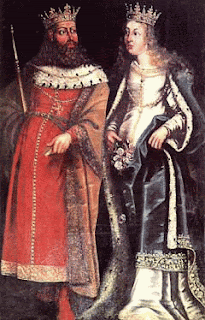Once upon a time, in a kingdom of its name Portugal, there was a Queen known by her kindness and good heart. Queen Isabel of Portugal was devoted to the poor and sick. Her generosity was very popular but her husband, a very good ruler, considered charity to be of high cost to the kingdom and forbid her to do so. One day the King – El-Rei D. Dinis, found the Queen in one of her charity actions, giving money and bread to the poor. Afraid of the King’s punishment, Queen Isabel hid the bread in her lap, and the King asked: “Where are you going?”, she said: “I’m going to the monastery to decorate the altars”. Distrustful, the King asks to see what she is bringing in her lap, she replies saying “Roses, my lord”. Not happy with this answer, the King charges the Queen of lying as it was impossible to have roses in January. Therefore, he forced her to open the mantle to show what she was hiding. When she opened the mantle, the most beautiful roses fell from her lap – the hidden bread was turned into roses. The King was speechless and apologized his Queen. The story ran the whole kingdom and Queen Isabel of Portugal was proclaimed Saint by her people, and officially by the Pope 3 centuries later, in 1614.
 |
| El-rei D. Dinis and his Queen, Isabel of Portugal |
This legend is still very popular in Portugal and Queen Isabel is still much loved by the Portuguese after all these centuries, so I decided to share this with you. Of course this story is not coming alone without some hard-core botanizing, so make yourselves comfortable and get ready for what really matters!
I must admit that roses are not my type of flower – at least the ornamental roses; but they are an important group for the flower evolution point of view and that is enough to make me want to talk about it!
When talking about roses, maybe most people think about love, romantic stuff, Valentine’s day, maybe gardening or perfumes, but I have to be honest – the first thing crossing my mind is hypanthium. Not very romantic at all, right? But yeah, what is the real meaning of that weeeird word? And why do I think about hypanthia when thinking about roses?
When talking about roses, maybe most people think about love, romantic stuff, Valentine’s day, maybe gardening or perfumes, but I have to be honest – the first thing crossing my mind is hypanthium. Not very romantic at all, right? But yeah, what is the real meaning of that weeeird word? And why do I think about hypanthia when thinking about roses?
 |
| Roses from QSBG Rose Garden, Thailand |
It is basically an elongation of the receptacle of the flower, and this lead to a lot of discussion in terms of the morphology of the flower as well as the naming of floral structures. With the elongation of the receptacle, sepals, petals and stamens are lifted up, and this causes confusion, “Is this a superior or inferior ovary?” Well, usually is neither both – it’s a half-inferior ovary!!
 |
| Ovary position related with the origin of the hypanthium |

very nice story! and i didn't know it!
ReplyDeletebut when you see a rose you think.. hypanthium?
there's something very wrong with you...
I know, I can't help it - I'm a botanist! =D
ReplyDeleteprada handbags, http://www.pradahandbagsoutlet.co.uk/
ReplyDeleteevening dresses
michael kors factory outlet, http://www.michaelkorsfactoryoutletonline.com
vikings jerseys
nike air max uk
nike free,nike free run,free running,free run,nike running
ysl outlet online
spurs jersey
nike running shoes
cheap soccer jerseys
toms shoes
coach outlet online
cheap uggs, http://www.uggboot.com.co
kate spade handbags, http://www.katespade-handbags.us.com/
peter konz jersey,paul worrilow jersey,prince shembo jersey
kobe bryant jersey
nike air max
toms outlet, http://www.tomsoutlet-stores.com/
cheap ugg boots
true religion outlet,true religion jeans,true religion kids,true religion jeans sale,true religion jeans for men,true religion jacket,true religion sale
wedding dresses
michael kors factory outlet, http://www.michaelkors-outlets.us.com
lance briggs jersey,martellus bennett jersey,jay cutler jersey,sylvester williams jersey
michael kors outlet, http://www.michaelkorsoutletonlinestores.us.com/
rolex watches
aaron rodgers jersey,clay matthews jersey,cheap reggie white jersey,matt flynn jersey,jamari lattimore jersey,randall cobb jersey
patriots jerseys
oakley outlet, http://www.oakleysunglasses-outlet.us.com
lebron 12
michael kors outlet store, http://michaelkors.outletonlinestores.us.com/
mm0902
vans shoes
ReplyDeletehermes online
supreme clothing
michael kors outlet store
kobe shoes
moncler jackets
kevin durant shoes
supreme shirt
off white
balenciaga
xiaofang20191215
lebron james shoes
ReplyDeletejordans
yeezy shoes
lebron shoes
bape clothing
spongebob kyrie 5
kyrie 7
off white jordan 1
lebron 18
off white nike